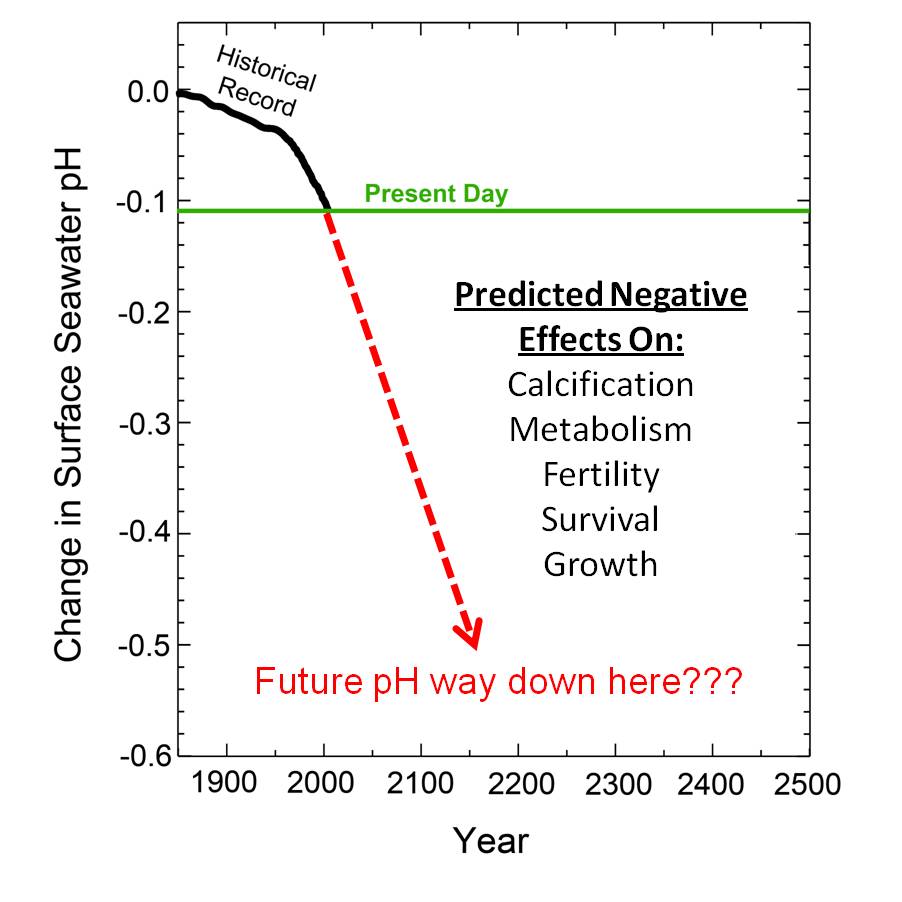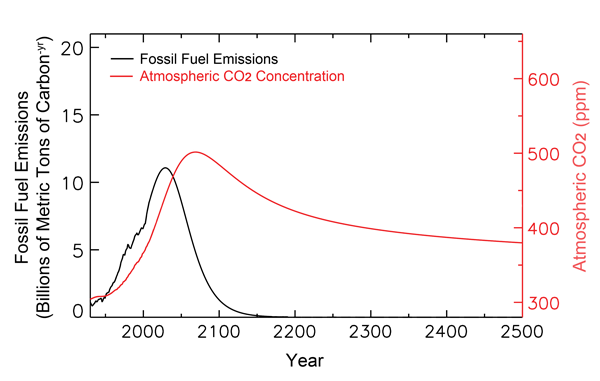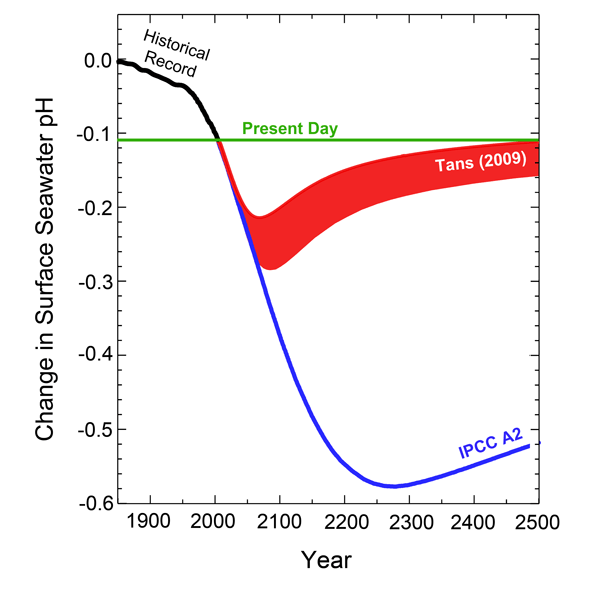Background and Introduction
According to climate-alarmist theory, as the air's CO2 content rises in response to ever-increasing anthropogenic CO2 emissions, and as more and more carbon dioxide therefore dissolves in the surface waters of the world's oceans, the pH values of the planet's oceanic waters should be gradually dropping.
 It has been estimated, for example, that the globe's seawater has been acidified (actually made less basic) by about 0.1 pH unit relative to what it was in pre-industrial times; and model calculations imply there could be an additional drop somewhere in the neighborhood of between 0.3 to 0.7 unit by the year 2300. A potential pH reduction of this magnitude is viewed by many as a cause for great concern; for it has been postulated to harm calcifying marine life such as corals, not only by reducing the calcifying rates of marine organisms, but also by negatively impacting their rates of metabolism, growth, fertility and survival.
It has been estimated, for example, that the globe's seawater has been acidified (actually made less basic) by about 0.1 pH unit relative to what it was in pre-industrial times; and model calculations imply there could be an additional drop somewhere in the neighborhood of between 0.3 to 0.7 unit by the year 2300. A potential pH reduction of this magnitude is viewed by many as a cause for great concern; for it has been postulated to harm calcifying marine life such as corals, not only by reducing the calcifying rates of marine organisms, but also by negatively impacting their rates of metabolism, growth, fertility and survival.
This ocean acidification hypothesis has gained great momentum in recent years because it offers an independent path to regulate fossil fuel emissions in addition to that provided by concerns over traditional global warming. For even if the models are proven not to be correct with respect to their predictions of atmospheric warming, extreme weather, glacial melt, sea level rise, or any other attendant catastrophe, those who seek to regulate and reduce CO2 emissions have created a fall-back position that states that no matter what happens to the climate, the nations of the earth must reduce greenhouse gas emissions because of their direct impacts on marine organisms via ocean acidification.
Over time, the rhetoric of these acidification alarmists has risen tremendously, as illustrated in a couple of quotes from a short, 21-minute film released in late 2009 by the Natural Resources Defense Council entitled Acid Test: The Global Challenge of Ocean Acidification. Featuring Sigourney Weaver as its narrator, the film highlights the alarmist views of a handful of scientists, a commercial fisherman and two employees of the NRDC, as they discuss what they claim is a megadisaster-in-the-making for Earth's marine life.
The villain of the story is industrial man, who has "altered the course of nature" by releasing large quantities of carbon dioxide into the air via the burning of coal, gas and oil. According to Ken Calderia, a professor at Stanford University, "by mid-century, if we continue emitting carbon dioxide the way we have been, entire vast areas of both the Southern Ocean and the Arctic Ocean will be so corrosive that it will cause sea shells to dissolve," leading him to conclude that "we're really in the last decades of coral reefs on this planet for at least the next, let's say million plus years, unless we do something very soon to reduce CO2 emissions. We're moving from a world of rich biological diversity into essentially a world of weeds."
Not to be undone, Dr. Ove Hoegh-Guldberg of The University of Queensland says:
- "We know that coral reefs are particularly sensitive to ocean acidification. And the reason for that is that corals are unable to form their skeletons as quickly as they used to, and reefs are starting to crumble and disappear. We may lose those ecosystems within 20 or 30 years. ... We've got the last decade in which we can do something about this problem. But it is very, very clear that if we don't start to deal with it right now, with very, very stern cuts to emissions, we are going to condemn oceans to an extremely uncertain future."
 The ocean chemistry aspect of the ocean acidification theory is rather straightforward; but it is not as solid as model projections, alarmist scientists, politicians, or movie stars make it out to be. For example, a number of respected researchers have published papers claiming that the drop in oceanic pH will not be nearly as great as the IPCC and others predict.
The ocean chemistry aspect of the ocean acidification theory is rather straightforward; but it is not as solid as model projections, alarmist scientists, politicians, or movie stars make it out to be. For example, a number of respected researchers have published papers claiming that the drop in oceanic pH will not be nearly as great as the IPCC and others predict.
This figure to the right shows much of the past and projected history of fossil-fuel carbon utilization, together with historical and projected atmospheric CO2 concentrations out to the year 2500, as calculated by NOAA's well-respected Pieter Tans (2009). As can be seen here, his analysis indicates that the air's CO2 concentration peaks well before 2100 and at only 500 ppm, as compared to an 800 ppm value predicted in one of the IPCC's scenarios. It is also worth noting in this graph that by the time the year 2500 rolls around, the air's CO2 concentration actually drops back to about what it is today.
 When these emissions estimates are transformed into reductions of oceanic pH, it can readily be seen in the figure to the left that Tans' projection at 2100 is far below that predicted by the IPCC. And Tans' analysis indicates a pH recovery to values near today by the year 2500, clearly suggesting that things are not the way the world's climate alarmists make them out to be when it comes to potential effects of anthropogenic CO2 emissions and their effects on the air's CO2 content and oceanic pH values.
When these emissions estimates are transformed into reductions of oceanic pH, it can readily be seen in the figure to the left that Tans' projection at 2100 is far below that predicted by the IPCC. And Tans' analysis indicates a pH recovery to values near today by the year 2500, clearly suggesting that things are not the way the world's climate alarmists make them out to be when it comes to potential effects of anthropogenic CO2 emissions and their effects on the air's CO2 content and oceanic pH values.
Another reason to not jump on the ocean acidification bandwagon is the fact that, with more CO2 in the air, additional weathering of terrestrial carbonates is likely to occur, which would increase delivery of Ca2+ to the oceans and partly compensate for the CO2-induced decrease in oceanic calcium carbonate saturation state. In addition, as with all phenomena involving living organisms, the introduction of life into the ocean acidification picture greatly complicates things. A number of interrelated biological phenomena, for example, must also be considered; and when they are, it becomes much more difficult to draw such sweeping negative conclusions.
In fact, as demonstrated in numerous reviews of the scientific literature that we have published on our CO2 Science website, these considerations even suggest that the rising CO2 content of Earth's atmosphere may well be a positive phenomenon (see, for example, the many topics listed under Calcification and Ocean Acidification in our Subject Index).
Nevertheless, articles continue to be published in peer-reviewed journals on both sides of the issue, making it difficult to get to the bottom of what impact rising atmospheric carbon dioxide will really have on marine life. For every article that seems to present the issue in a negative light, there is a counter article that presents it in a positive light. With the creation of our Ocean Acidification Database, however, our understanding of this important issue has taken a giant leap forward.
Debuting with over 1100 experimental results from the peer-reviewed scientific literature, our database details the responses of various growth and developmental parameters of marine organisms immersed in seawater at or near today's oceanic pH level, as well as lower than that of today. More results are continually being added to the database on a regular basis as additional studies from the peer-reviewed scientific literature are published. Freely availabe to all, this database represents the largest quantitative analysis ever conducted on the subject of ocean acidification.
Continue onward by selecting one of the links below.




